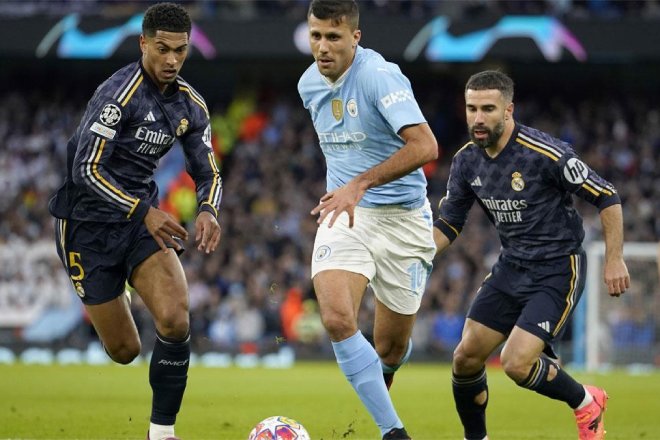 Mes Que Un Club!
Mes Que Un Club!
It’s a motto that was coined quite recently in the club’s history. In January of 1968 Narcis de Carreras, newly-appointed president of Barcelona football club, upon making his acceptance speech, gave voice to the slogan “mes que un club!”
It reveals a sentiment that has been at the heart of the club’s philosophy almost since its beginnings.
To the people of Catalonia, FC Barcelona serves as a haven of Catalan culture, and in a wider sense stands for democracy and human rights.
How deeply ingrained in the club’s ethos is this philosophy? The club’s very statutes speak to it, mentioning “a permanent tradition of loyalty and service to club members, citizens and Catalonia.” And although the club initially intended to serve the Catalan people, over time it has positioned itself as a model of social equality for all Spaniards.
The bloody Spanish Civil War, which ravaged the Iberian Peninsula from 1936 to 1939, gave rise to FC Barcelona as a symbol of Catalan resistance and Republican sentiment in the face of Franco’s Nacionalistas, whose regime suppressed the cultural differences of Catalonia and other regions of Spain.
Catalans in the thousands joined FC Barcelona, in whose support they were able to give voice to their traditions and indeed their very language, the use of which had been banned. In so doing the Catalan people demonstrated their resistance to Franco, while left-leaning Spaniards across the country saw FC Barcelona as something of a Republican icon.
A Walk in the Rain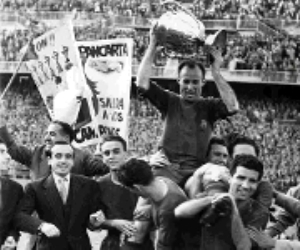
A famous incident symbolizes Barca’s position in Catalan society as well as Catalan resistance to oppression. In 1951 the people of Barcelona initiated a general strike to protest the social and economic conditions in the country.
The strike was triggered by a 40% hike in the city’s tram fares. The people boycotted the trams, with the strike reaching its climax in March of that year. Barcelona fans figured prominently in the course of events.
A match against Santander provided the flashpoint. It was a home match in Barcelona, which Barca won 2-1. The authorities expected the thousands of Barca fans at the game to break the tram boycott and travel home by rail as usual.
And since the rain was falling that day this may have seemed a reasonable expectation. The authorities had underestimated the resolve of the people, however, and the Blaugrana supporters chose to walk home in the rain, some for many miles, leaving the trams empty of passengers.
It was seen as a powerful statement, and a surprising one to the government, who could ill afford to continue to lose revenue from the public transport system. Several days later the price hike was repealed.
The central government in Madrid initiated additional heavy-handed restrictions intended to break the will of the Catalans, but the stand taken by the people of Barcelona encouraged further social unrest throughout Spain that would plague Franco’s dictatorship and ultimately lead to social and economic reforms across the country.
Arguably then, here is the true meaning of “mes que un club:” that FC Barcelona stands for social and economic equality for Catalans and all Spaniards.
And yet the key figure in the founding of the club was not a Barcelona man at all. Nor was he a Catalan. Indeed, he wasn’t even Spanish.
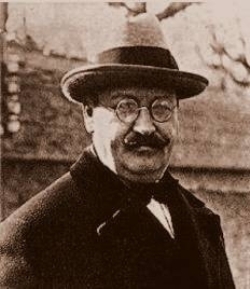 The Man Behind FC Barcelona
The Man Behind FC Barcelona
Hans-Max Kamper was Swiss. Later in life he Latinized his name and has become known to generations of Barcelona fans as Joan Gamper. He was born in the town of Winterthur, in the German-speaking, Swiss Canton of Zurich, in November of 1877.
By all accounts Gamper was a passionate sportsman: cyclist, runner, golfer, rugby player. Tennis anyone? Yes, he played that sport too. He also loved football. And he was particularly good at football.
As a young man in Switzerland Gamper played football for FC Basel. He is said to have been one of the early captains of that club. Later accounts suggest he was instrumental in the founding of FC Zurich, before making his way first to Lyon in France and then on to Barcelona.
The circumstances of FC Barcelona’s beginnings show a striking similarity to the founding of FC Basel six years before: In both cases an advertisement was placed in a local paper inviting persons interested in playing football to show up at an appointed place and time. Those who presented themselves formed the nucleus of a club.
We know that Gamper placed the famous ad in the Barcelona sports paper Los Deportes. Did he also place the similar ad in the Basel newspaper six years earlier? If he did he must have been a most mature and forward-thinking young fellow, for he was just 16 at that time, and FC Basel would therefore have been the first of three major football clubs in whose founding Gamper had been involved.
Whatever Gamper’s connections with the football clubs of Basel and Zurich, they are mere footnote to the overarching history of a life permanently linked to FC Barcelona.
Unfortunately Gamper came to a sad end. Financial and personal problems caused him to commit suicide in 1930. His name lives on however, in the Joan Gamper Trophy, an annual pre-season competition hosted by FC Barcelona.
FC Barcelona is Born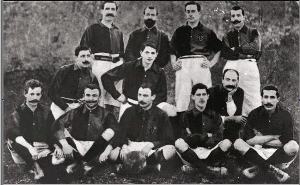
In 1898 Hans-Max Kamper was on his way to Africa for business purposes. His journey took him through Barcelona, where he had an uncle whom he planned to visit before leaving Europe. The Catalan city apparently got a grip of young Hans and he abandoned his African expedition, choosing instead to build a career in Catalonia.
As a sportsman he undoubtedly felt the urge to compete and he took up football with a local church team while earning a living as an accountant and sportswriter. It is said he had a hand in the creation of the sports publication Los Deportes. His involvement with that publication would lead to greater things.
In October of 1899 Kamper, later to be known as Joan Gamper, placed an advertisement in Los Deportes inviting all interested persons to join him in forming a football team. A month later the respondents, a mixed company of Swiss, Spanish and English, met for the first time and “Foot-Ball Club Barcelona” was born.
Joan Gamper went on to become a celebrated player with a distinguished goal-scoring record. According to the official FC Barcelona website, Gamper played 51 games for the club from 1899 to 1903 and scored a quite remarkable 120 goals!
Granted, much of Barcelona’s competition at the time would have been less robust than they typically find among modern opponents. Nevertheless, Gamper’s marksmanship can be seen as a testament to his athletic skills, and in the 1901/02 season he helped the club win its very first trophy, the Copa Macaya.
Gamper later went on to become president of the club, and served in that capacity on five separate occasions. During his first presidency, commencing in 1908, he guided the financially ailing club to fiscal stability, increased membership and the acquisition of its first stadiums, the Camp de la Industria, with a capacity for 8,000 spectators, and later Camp de les Corts, which was eventually expanded to a capacity of 60,000 spectators and which FC Barcelona called home from 1922 until 1957.
Camp de les Corts witnessed FC Barcelona’s two most successful periods in the first half of the 20th Century. In the 1920’s when English manager Jack Greenwell and players such as Platko and Alcantara, and in the 40s and 50s with players like Kubala, Kocsiz and Suarez.
By the ‘50s, however, the club had outgrown Les Corts and in 1957 FC Barcelona took up residence at the famous stadium they call home today, the Camp Nou.
 FC Barcelona Honors
FC Barcelona Honors
Since its founding FC Barcelona has won more trophies than any other Spanish club, including its great rival Real Madrid. The club trophy case contains the silverware from 20 Spanish league championships, 25 Spanish Cup wins, 9 Spanish Super Cup wins, 2 League Cup wins, 3 European Cup/Champions League titles, 4 European Cup Winners Cup titles, 3 European Super Cup wins, a FIFA Club World Championship, and numerous lesser titles.
Barca is the only club in Europe to have qualified for European competition every year since 1955, and they have never been relegated from the Spanish top flight.
The Blaugrana – the Colors of FC Barcelona
The famous blue and claret colors of FC Barcelona, the “blaugrana,” have been worn since the club’s founding, but the origins of the colors are wrapped in some mystery. No one seems to know definitively why these particular colors were chosen.
A common notion holds that Joan Gamper chose the colors in honor of his previous club, FC Basel. This seems a reasonable assumption, since the Basel club have played in the same claret/blue color combination longer than Barca.
FC Barcelona’s official website, however, refutes this idea, although it gives no reason why, nor does it offer any more reasonable alternative.
Another notion is that the colors were chosen by Arthur Witty an Anglo-Catalan businessman (and former player) who became club president in 1903. Witty is said to have adopted the colors of the rugby team from the Merchant Taylors School on Merseyside where he had been educated.
Other theories persist about the colors, some rather fanciful in nature. (The Barca official website offers the “unproven theory” that the colors were adopted “from the blue and red accountancy pencils that were so popular at the time” the club was founded.)
Theories of the meaning behind the colors aside, there’s no doubt that the club’s remarkable success has made the Blaugrana recognizable worldwide. Such success, of course, must be attributed to the quality of the players, and some of the world’s best have draped themselves in claret and blue.
 The Great Players of FC Barcelona
The Great Players of FC Barcelona
First mention among the great Barcelona players must go to Johan Cruyff. Widely recognized as the World’s finest player in his day, the Dutchman played for Barcelona from 1973 to 1978, and helped them win La Liga in the ’73-74 season after a drought of 14 years. He returned in 1988 and managed the Blaugrana into a period of dominance on the Spanish and European scenes, capped by a European Cup win in 1992.
A march through the decades, however, gives us many a legendary figure.
There is the aforementioned Ferenc Platko, the Hungarian goalkeeper who played for Barca from 1923 until 1930, and whose bravery inspired poet Rafael Alberti’s Ode to Platko.
Platko’s era was also graced by the Philippines-born, Paulino Alcantera, who debuted for the Blaugrana in 1912 at the age of 15 and became the club’s greatest goal scorer, with 357 goals in 357 games!
Josep Samitier was the second most prolific scorer in club history. He played for the Blaugrana from 1918 until 1933 and scored 326 goals. His popularity was a big factor in the club’s need to move from the old Camp de la Industria to the larger-capacity Les Corts.
A later period witnessed the arrival of the hugely influential Hungarian Ladislao Kubala, who played for Barca from 1950 to 1961, scoring 274 goals. Kubala had escaped Hungary following the communist takeover.
Yet Kubala might never have come to prominence were it not for his son. The boy, who along with his mother had followed Kubala to freedom, had fallen ill during what must have been a strenuous escape. Because of his son’s illness Kubala turned down an opportunity to join the Torino club for a match against Benfica in Lisbon. The decision saved his life, for the plane carrying the Torino club crashed outside Turin with the loss of all aboard.
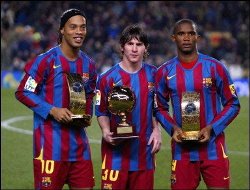 Returning to the era of Cruyff and beyond a veritable pantheon of football gods wore the Blaugrana: Maradona, Neeskins, Laudrup, Koeman, Romario, Stoichkov, Rivaldo, Guardiola, Ronaldo and of course, the once beloved, now despised, Figo are just a few of the greats from the modern era of Barcelona football.
Returning to the era of Cruyff and beyond a veritable pantheon of football gods wore the Blaugrana: Maradona, Neeskins, Laudrup, Koeman, Romario, Stoichkov, Rivaldo, Guardiola, Ronaldo and of course, the once beloved, now despised, Figo are just a few of the greats from the modern era of Barcelona football.
Some had more impact than others. Maradona and Ronaldo, for example, served the Catalan club only briefly, while the likes of Laudrup, Koeman and Guardiola became fixtures in the Blaugrana line-up.
Today FC Barcelona continues to field players of magnificent skill who evoke football at its finest: Eto’o, Ronaldinho, Messi, Puyol to name a few.
To call these players stars is almost to diminish their stature in football for they, like the club the play for, seem to transcend the game. One is almost tempted to call them superstars, which they clearly are. But superstar in Spanish is Galactico, and no fan of Barca wishes to be connected in any way with “Los Galacticos,” better known as Real Madrid.
To know about Real Madrid's history, click here.
To read more about Barcelona and Real Madrid's history in El Clasico click here.



